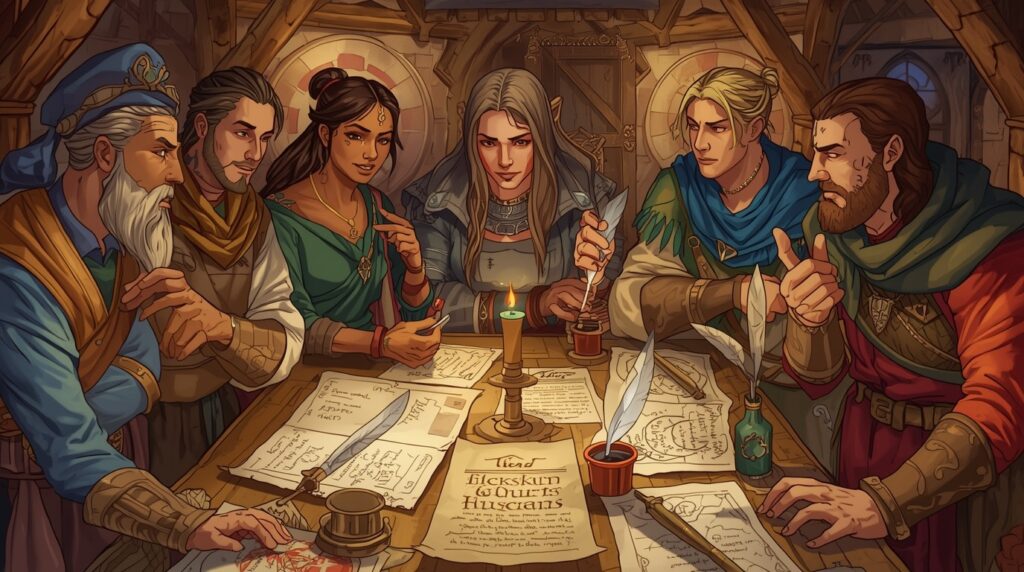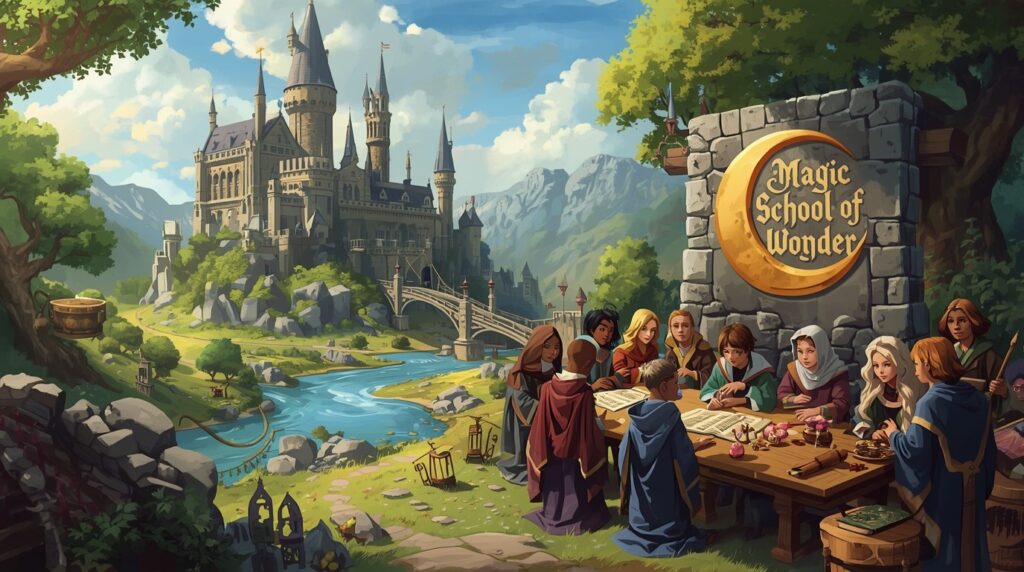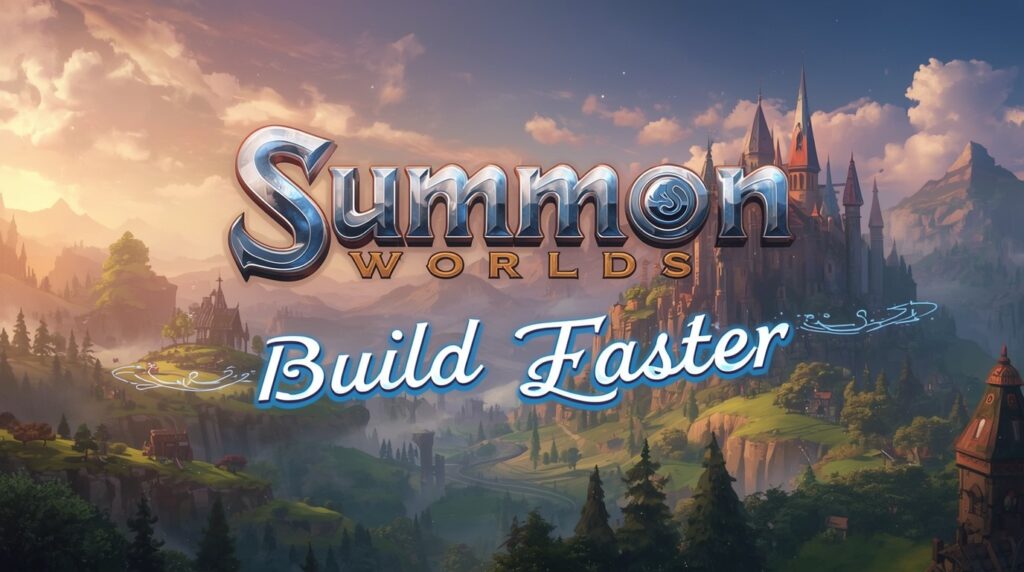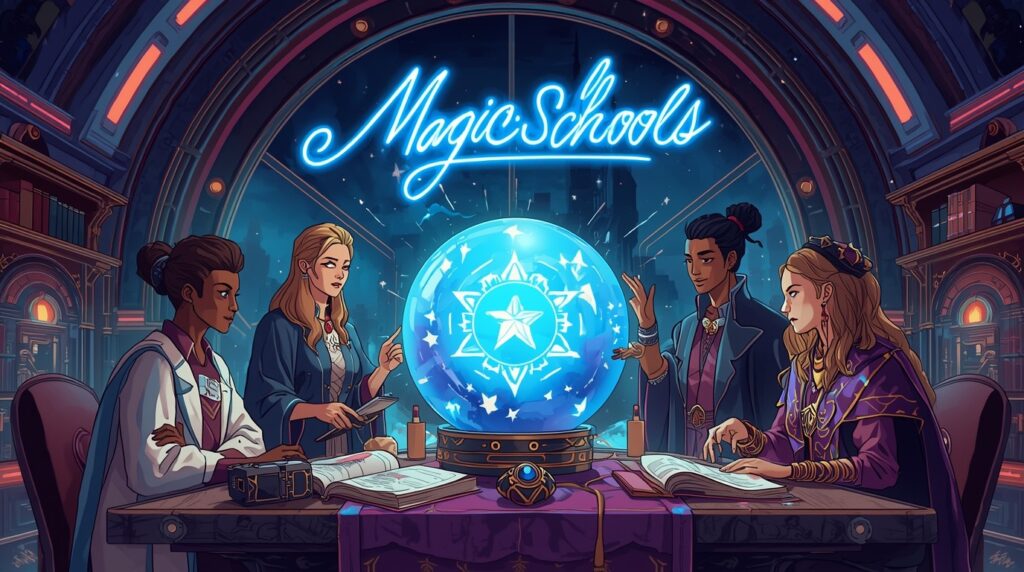Designing Magic Schools, Guilds & Factions with AI
What if your school bell could shake a city?
Picture the halls before dawn. Wards hum. Doors watch. A first-year steps wrong, and the street outside pays the price. That is the risk. That is the pull. A Fantasy magic school is not just a campus. It is a pressure point. Touch it, and the whole world moves.
You want tight prep. You want names, rules, and scenes that hit hard. You want students’ understanding to be clear from day one. No fog. No filler. You want guilds that pay the bills. You want factions that smile in public and scheme at night.
Here’s the twist. You can build all of it fast and still keep your voice. A simple plan. A few sharp rules. One helpful AI tool to speed up the grunt work. The rest is you.
🗣️So ask yourself: who gets in, who gets hurt, and who profits when a spell goes wrong? If you can answer that, your world has teeth. Keep reading. The steps below will help you shape the school, the guilds, and the factions, and turn every page into a choice that matters.
Table of Contents
How a Fantasy Magic School Works: Key Elements and Structure
A great school has one purpose, you can say in one breath. “We train wardens who keep the city safe.” That one line guides classes, exams, rules, and jobs after graduation. Keep it posted in your notes. Let every scene test it.
Admissions that create story
Who gets in sets the tone. Pick one rule and stick with it. Talent trials. Lineage. A sponsor letter. A lottery. Tuition or years of service owed. The rule shapes class mix and pressure. It also tells you who waits outside the gates with hope or hate.
A campus that supports the promise
Sketch five places. Give each a clear use and one risk. Wards Lab (burnout risk). Healers’ Court (crowds form). Quiet Stacks (restricted shelves). South Gate (city spillover). Bell Tower (familiars gather). These small notes make scenes easy to stage.
Curriculum that teaches action
Think like a trade school with ethics. Use five tracks that show up in play:
- Core Theory: limits, costs, and what magic cannot fix.
- Practice: drills, duels, and safe labs.
- Ethics & Law: consent, bans, civic duty.
- Field Work: patrols, relief work, ward repair.
- Mundane Skills: history, languages, math.
Short classes. Clear tasks. Exams that change how the city sees the school.
Understanding Safety, Rules & the Real Cost of Magic in a School Setting

Power needs a price. Write three hard rules and the cost to break them. For example: no mind control; no summoning in dorms; no off-campus travel spells without a license. Set the costs you will enforce. Fines. Mana drain. Service. Expulsion. Trial. Publish the code inside your notes. Apply it to staff as well. Fair rules build trust and fear at the same time.
🧫Culture and paths that do real work
Houses or paths should not be a mood. They need duties. Wardens defend. Seekers research. Hands heal. Lumen serves the city. Give each a color, a crest, one ritual, and one flaw. That is enough for tension, pride, and fun rivalries.
🧙♂️Staff who push the story forward
Write staff like player characters. Each needs a goal, a secret, and a method. A dean who needs funding. A field chief who bends rules. A librarian who guards banned tomes. Let them act on stage. Let them disagree in public. Students will pick sides. You will get scenes for free.
Guilds That Power Daily Life: Ranks, Charters & Economy
Guilds keep the city running. They also give players clear ladders to climb.
Ranks and rights that feel fair
Use six ranks at most. Apprentice. Journeyman. Senior. Master. Councilor. Guildmaster. Tie each rank to one duty, one perk, and one test. Journeyman gets paid contracts, access to the vault, and a solo task to prove skill. Master trains others, leads teams, and votes on charters. Keep it visible so everyone knows where they stand.
A charter that stops fights
A simple charter saves hours of debate. Cover five points in a page: scope of work, dues and cuts, how the guild defends members, how you judge claims, and what secrets the guild keeps. If it makes money, it makes enemies. That is good news for your plot.
Services, economy, and signs
Write how the guild earns coin. Training. Contracts. Repairs. Wards. Maps. Show the hall, a token, and a call phrase. Small symbols make scenes pop and help readers remember who is who.
Factions That Shape the City and Story: Goals, Methods & Conflict

A faction needs three things to matter: a goal, a method, and a resource. With those, each scene gains choices and heat.
🧱The basic faction block (use it again and again)
- Name and type.
- Goal (win state in one line).
- Method (how they act).
- Leader (trait and flaw).
- Assets (money, land, people, magic).
- Symbols and colors.
- Rivals and allies.
- Three hooks: jobs or story beats.
You can fill one of these in five minutes and get a week of play from it.
✨Reputation that reacts
Track standing from −3 to +3. Publish what each level means. At −2, members refuse service. At 0, they are polite but cold. At +2, doors open, and help arrives. Let actions move the score. People will care because the world cares back.
Build Faster with Summon Worlds: Your AI Tool for Fantasy Worldbuilding

You can do all of this by hand. You can also speed it up with one ai tool that keeps your ideas in one place. Summon Worlds helps you plan, chat in character, and make art that locks in the look.
- Start with people: Create a headmaster, a field leader, and a rival dean. Auto-generate a backstory for each. Edit in your voice. Save the trio to a Collection so they stay together.
- Shape the organization: Ask Character Chat to draft a one-page school code from your notes. Add memory so the chat remembers laws, tone, and names across sessions. Update the code when your story changes.
- Build factions: Make three faction blocks with clear goals and methods. Put them in a Collection called “City Forces.” Tag them for quick search later.
- Create symbols that stick: Use AI Art to make a crest, house banners, and guild tokens. Try Epic Fantasy, Steampunk, or Anime styles to match your mood. Add a short prompt. Generate a set. Pick the best and save.
- Test scenes: Open AI Character Chat. Speak as a student. Let the dean answer in voice. Ask hard questions about duty, safety, and cost. You will spot gaps fast.
- Prep for tables: Use 5e tools to auto-build character sheets for mentors and rivals. Edit stats. Export notes. Your work is ready for a session tonight.
🧭 Ready to Build a Fantasy Magic School People Remember?

What if your next session feels ready in one hour?
You now have the bones, the rules, and the spark to build a Fantasy magic school that actually moves the city around it. Your guilds have ladders people can climb. Your factions have goals that bite back. Scenes flow. Stakes stick. Students’ understanding rises fast because the world is clear.
Here’s your next move. Pick one promise for the school. Write three laws with real costs. Sketch two factions and one guild. Then let one scene test all of it. Keep the best parts. Cut the rest. Simple.
Need speed without losing your voice? Use Summon Worlds as your AI tool. Create characters, chat in-world, and make crests and banners in minutes. Keep drafts private. Share when you’re ready.
👉Ready to start right now? Open Summon Worlds and build your first class, your first exam, and your first plot hook tonight.
Disclaimer: Summon Worlds and the content on summonworlds.com are not affiliated with, endorsed by, or sponsored by Wizards of the Coast LLC. Dungeons & Dragons, D&D, and related terms are registered trademarks of Wizards of the Coast. Any references to D&D game mechanics, settings, or terminology are made for educational, commentary, and fan content purposes only. This blog does not reproduce or distribute official D&D content. All original ideas, characters, and creative content in this post are the intellectual property of OpenForge LLC, the parent company of Summon Worlds.





